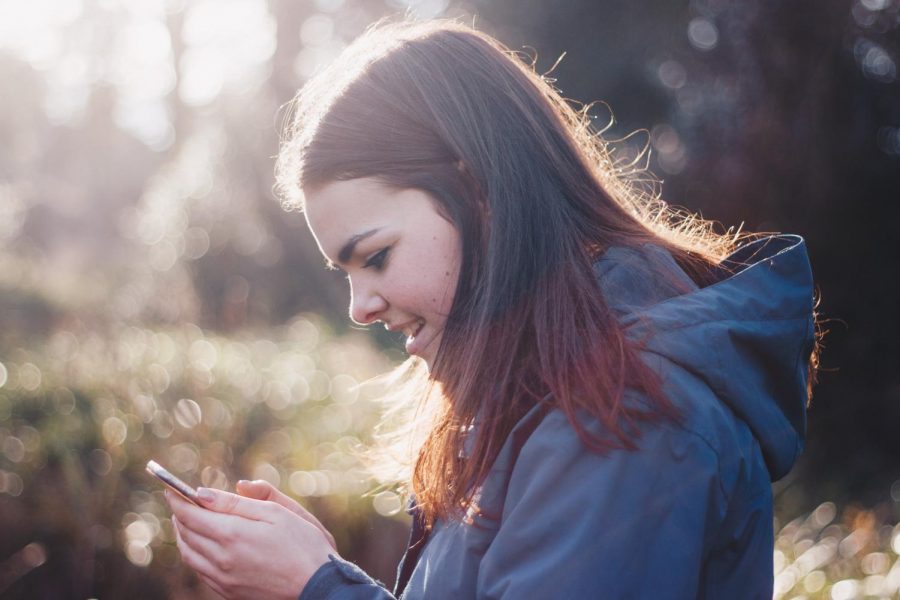Snapchat: The Addiction at Your Fingertips That’s Worth Quitting
April 11, 2018
Just about every high school student who has a phone probably has Snapchat to check in with their friends and communicate with photos that only last for a few seconds. Although users claim to hate the app’s features and new updates, teens are still constantly using the app. Speaking from personal experience, I can say that teens need to take a break from Snapchat.
Snapchat started out primarily as a communication app, where users could take pictures instead of text messaging. However, when the app started to get more popular, remodels started to come out. The upgrades improved the app immensely. Updates have included a memories folder, location tracker, a “My eyes only” folder, unlimited replays, and snaps that last for infinity seconds.
One of the most well known features on Snapchat is a streak, which is a number that tells users how many days they have snapped someone in a row. Many teens use streaks as a popularity poll. They are constantly worried about how many streaks they have, how long the streaks are, and if their streaks are going to end soon.
Safety can also be a big issue on the app. Teens can get so obsessed with Snapchat streaks that they have streaks with people they don’t know. Snapchat can be a scary place, especially when anyone can add anyone as a friend.
It is very common for teens to communicate with each other with pictures of black screens, even though the app is meant for picture taking. Therefore, talking to strangers isn’t uncommon. It is also possible for users to communicate by swiping over to a text message feature. As a result, they don’t have to take pictures of themselves to talk to each other.
Most teens also have their Snapchat username in their Instagram bio. This means that anyone on the internet, even if the account is private, can add those users on Snapchat. At least one person a day posts something on Instagram that usually goes along the lines of: “Add me on snap!”
Snapchat is a huge competition, even though no one will admit it. Everyone wants to have the biggest snap score, which is a number that tells other people how many snaps a person has sent and received. Users also compete by the number of streaks they have, the amount of people that have viewed their story, or by who is in their best friend list. After a while, I became sick of the same story.
I recently took a break from snap by deleting it completely. I wanted a chance to see what would happen if I tried putting my phone down for a while, and the first step was getting rid of my most addictive app. Not only was I addicted to responding to anyone who snapped me, I was addicted to the environment it created.
Anytime I was with friends, I would snap them when they were right in front of me. I was a slave to my streaks. I would lose twenty to thirty percent of my phone’s battery life every morning on my way to school because I would be on the app. I would check my phone every two minutes to see if I had a snap and if I needed to respond. Sometimes I wouldn’t open snaps all day, so it looked as if I had a large amount of people wanting to talk to me. I would let my notifications add up to fifty snaps before finally responding to people. I was obsessed with what people would think of me, and I was living an unhealthy life.
With the app gone, I experienced many different roller coasters. I would struggle with traveling somewhere and not having the ability to show anyone what I was doing. I would think about all the photo opportunities around me and become sad. While on spring break, I wanted to discover all the interesting geofilters around me. Not to mention, I had absolutely no clue what everyone else was doing for spring break. I felt like I was left out and missing all the action.
After deleting Snapchat, I have become more aware of what people are doing around me. It seems I find myself in situations where I am the only person who isn’t on Snapchat. Everyone during lunch or after school is looking down on their phones. At the lunch table, my friends are possessed by their phones because they’re busy taking pictures of each other.
Snapchat causes damage to many relationships on top of that. It makes teens say irrational things, while teaching them to overreact to everything. One of the most common situations that ends up hurting someone’s feelings is leaving someone on read. People can get so hurt by this small action that clearly means nothing. For instance, just the other day my friend started loudly accusing a boy next to her because he left her on read when he put his phone down.
These actions are ridiculous. Teens are using the app to such an extent that eventually it is going to swallow them whole. It is taking over their emotions. They won’t know the difference between losing a five hundred day streak and losing a pet.
I’ll admit that Snapchat isn’t a completely bad thing. I have definitely missed it during my time without it, and the first couple days were very difficult. It’s how teens communicate and express themselves today. I miss taking funny videos of my friends while hanging out. I miss talking to all my friends with a tap on my screen. There have been some moments where I wanted to ask someone a question, but I didn’t have their number. Although the transition was hard, without a doubt, I needed a break.
I highly encourage teens to delete the app for a week, and see how you feel. We all need change every once in a while. I can’t guarantee you’ll enjoy it, but I can promise you that you will see things differently.
Photo by Luke Porter on Unsplash. Used with permission.






Dakota Canzano • Apr 13, 2018 at 9:21 am
Awesome article Mags! I feel like this needs to be shared with teens everywhere. I agree that once you give yourself a break from Snapchat, you start to make more real life connections with more people around you.
Nicole Khoury • Apr 12, 2018 at 1:33 pm
Great article Maggie! I’ve realized how much, especially since the Snapchat update, I’ve barely been using my phone and I can tell you that is a weight lifted off my shoulders. People tend to miss out on so much of this world when they’re always hooked on their phones and on social media. I agree with everything you send in your article! Definitely share this around with peers, friends, teachers, etc. 🙂
Mandy Sisul • Apr 12, 2018 at 11:29 am
I agree. Great article Maggie!
Sherri Keepes • Apr 12, 2018 at 11:21 am
Nice article Maggie, and kudos to you for taking a break. Being a teen today, with all of these distractions and the pressures to maintain a social media presence- is so, so TOUGH. I hope all students take the time to read what you wrote and give some thought to what might exist or could be possible with ALL the time (even half the time) they spend on social media, doing something/anything else. Time is precious, think about the possibilities…
Will Rakoz • Apr 12, 2018 at 9:21 am
Great Article Maggie that’s so cool and I have deleted it before and I felt so much better and had so much time to do things
Grace Elkhal • Apr 11, 2018 at 8:14 pm
This is a superb piece which should be read by every teenager across the nation. I constantly advise teenagers, from cousins to friends, to place their phones down, yet get silenced by mocks and comments of denial. Phones are truly consuming our generation and even infecting the youth. Most of all, I admire that you actually deleted snap chat and began a healthier lifestyle. You have inspired me to take action and make changes in my own life if others will not take my advice. From streaks to leaving people on read, Snapchat consumes peoples’ lives distracting them from school, family, and REAL RELATIONSHIPS. Shallow relationships and meaningless posts are forming relationships which are unhealthy and empty, talking with a person for 500 days straight, yet leaving us more disconnected than ever. Thank you for a piece of news that actually needs to be published and voiced to the public. Snapchat is a disease and needs to be treated, it is up to us to take the medicine.
Izzy Sprando • Apr 11, 2018 at 7:00 pm
I recently have been thinking about how much Snapchat and social media has taken over my life. This article has made me want to take a break from social media and start creating real life memories instead of digital ones.